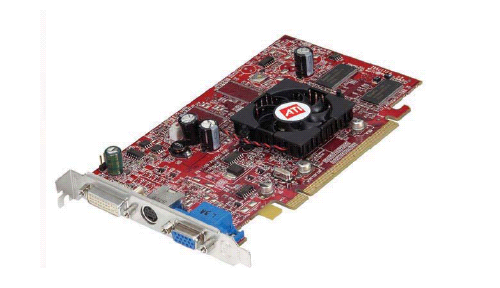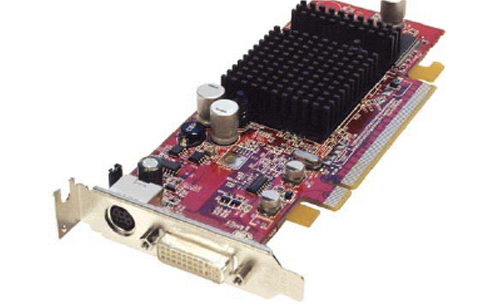New ATI Products Confirmed: The X Series Line-up
by Derek Wilson on June 1, 2004 6:00 AM EST- Posted in
- GPUs
X300 Debuts at 110nm

The PCI Express Radeon X300
In the same way that ATI moved into the 130nm low-k process with the 9600 line of cards, the RV370 GPU of the X300 will be fabbed on a 110nm process. As usual, TSMC is behind the silicon process that ATI is using.
It's good to see ATI sticking with a strategy that has worked for them. Taking an aggressive chance on one line of mid-range or low end GPUs before moving the rest of the parts to another process is a very good way to work out the kinks without incurring too much risk. In the worst case scenario, ATI could have covered the market segment with a lower clocked or otherwise handicapped version of a higher performing part while fixing what went wrong. What we have seen in the past with NVIDIA and large CPU vendors has consisted of large scale shifts in process technology, which can really hurt production and/or time to market if something goes wrong.
Among the benefits that ATI cites in TSMC's 110nm process is the ability to fit 40% more transistors in the same area as 130nm. A straight die shrink only accounts for about a 30% increase in space efficiency (1 - 1102 / 1302), so it stands to reason that TSMC must have made up the space savings in other areas of their process technology. Either way, this means that ATI has a lot of headroom with what they want to do with RV370.
Of course, with any new process, yeilds will be lower than what would be desired for the same performance level on an established process. Our theory is that ATI has worked out a way around this issue by taking the RV360 (Radeon 9600) core with a few tweaks, and fabbed it on a 110nm process, and dropped the clock speed way down in order to achieve acceptable yeilds. We can't be sure about this, as ATI isn't going to share yield rates or if this is actually a reason why they have taken this route. The pieces just seem to fit together too well, but it's still possible that it's all just coincidence.
The RV370 GPU will eventually be marketed as two parts: the Radeon X300 and the Radeon X300 SE. The SE part will have a cut-down 64bit memory interface similar to the 9200 SE. This value segment part will perform better than the 9200 SE part both because its based on the RV360 core, and its a higher clocked part. Hopefully, this also means that the compatibility issues we saw with the 9200 parts will fade into the distance as well. The regular X300 will have a 128bit memory interface.

This is the half-size btx version of the X300se.
We haven't seen any of these parts yet, but if we stumble across any on the show floor at Computex, we'll be sure to include pictures.
Now, on to the mobile arena.










10 Comments
View All Comments
Pumpkinierre - Tuesday, June 1, 2004 - link
Maybe 110nm is just on that limit where present technology allows the usual shrink/power reduction effect to be maintained without all the 90nm problems that really require a rethink to sort out. If that's the case it might be a good overclocker but could suffer from overvoltage or early death.quanta - Tuesday, June 1, 2004 - link
I wonder if anyone even cares about the 130nm X600 part, when they can just overclock 110nm X300 cards. But then again, die shrinks from 130nm to 90nm has given Intel a lot of trouble in the form of voltage leak and heat, I suspect X300 may not be able to run as fast as X600 without generate a lot more heat.Gholam - Tuesday, June 1, 2004 - link
Hmm, do I get it right that there won't be an 8-pipeline PCI-E Radeon? Straight from 4-pipeline X600 to 12-pipeline X800 PRO? Sounds somewhat strange... X800SE anyone?sxr7171 - Tuesday, June 1, 2004 - link
nserra - Tuesday, June 1, 2004 - link
#jcromanoNice explanation, have you used on processors too, like it would be amd 90nm athlon 64 die size?
This is much like digital camera 3mp to 5mp, it's almost the double but if you look at it, you would say it's only 30%/40% bigger. Or ati 160m transitors vs nvidia 222m. Ati is almost "big" but it has less 62m or a radeon 9600 less, funny isn't it?
Cycophant - Tuesday, June 1, 2004 - link
Small spelling mistake on the article intro:"Today, ATI fills out their new X series with three new PCI Express parts based on current __technolgoy__ that we are seeing. "
spikemike - Tuesday, June 1, 2004 - link
I don't believe blacks will look any blacker, you have to remember that the backlight is constant throughout the entire lcd. You can't control the brightness at a single pixel, so if you wanted to make blacks blacker then the whole screen would get darker, making the whites darker too, and in a very low darkness scene, you don't want to lose the black level resolution.vedin - Tuesday, June 1, 2004 - link
Darn..and I was really hoping that the X600 would be a little faster in the core and memory than the 9600XT. Say..550mhz? Honestly, I was hoping for a scaled down X800..so much for wishful thinking.jcromano - Tuesday, June 1, 2004 - link
I believe your claim that "a straight die shrink only accounts for about a 30% increase in space efficiency," found in paragraph 3 of the page titled "X300 Debuts at 110nm," may be in error.I'm not really sure what "space efficiency" is, but you make this claim in contrast to ATI's claim of a 40% increase in transistors per given area.
Assuming that the number of transistors per unit area scales inversely with the square of the (linear) process size, we have:
transistor density = k/d^2
For the old 130nm process, then,
transistor density (old value) = k/130^2.
For the new 110nm process,
transistor density (new value) = k/110^2.
The generally accepted way of presenting a percent increase or decrease is to use the old value as the denominator of the fraction. A formula such as this one would be appropriate:
(new value/old value) - 1
where the result is re-expressed as a percent, and a positive result is interpreted as an increase.
If we plug in, using k/110^2 for the new value (numerator) and k/130^2 for the old value (denominator), and cancel the k's, we get
130^2/110^2 - 1 = .39669 = 39.669%, which is admittedly lower than the 40% claimed by ATI, but close enough for me.
ducsauce - Tuesday, June 1, 2004 - link
I wonder if ATI will put out an All-in-wonder version of the x800 some time this year. The AIW 9800 pro is not going to keep up for long.